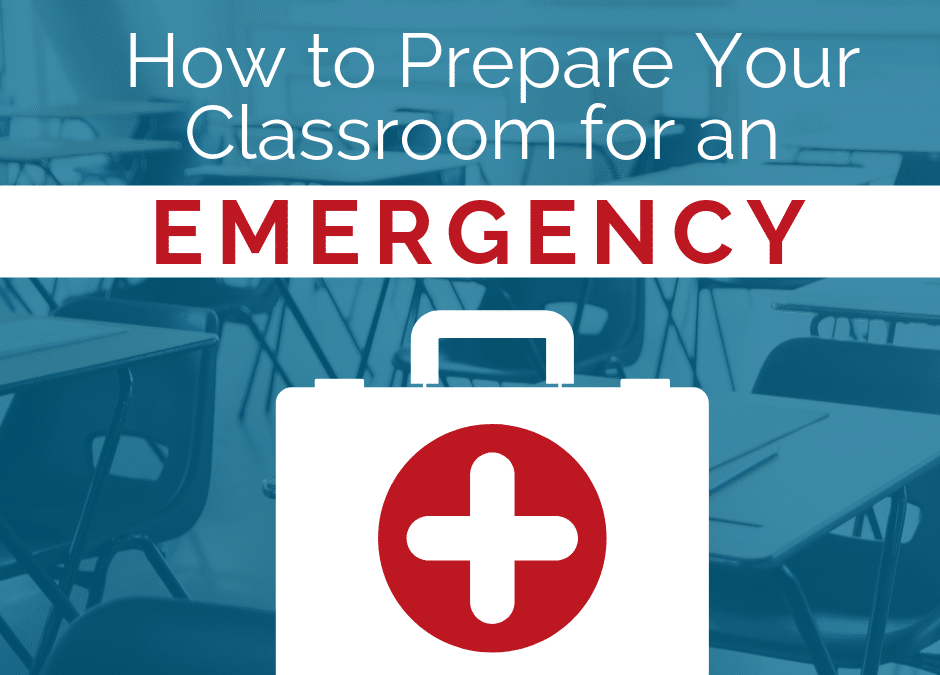Our Education Blogger is a public school teacher with over a decade of experience. She’s an active NEA member and enjoys writing about her experiences in the classroom.
Emergency situations can happen any place and at any time, that is why it is important to prepare your classroom for any type of emergency.
1. Know Your School Emergency Procedures
Be aware of your building’s emergency procedures, how often drills are practiced, and the expectations of teachers and students during such drills. Your building should have protocols in place in the event of a fire, tornado (in certain regions), earthquake (in certain regions), intruder, and medical emergencies. Take time each month to review procedures with students and go over lockdown/evacuation routes and guidelines.
2. Learn where Medical Equipment is Located
Does your building have an AED (Automated External Defibrillator)? All fifty states have laws or regulations requiring that AEDs be available in public gathering places, and in some states this means schools must keep and maintain AEDs. Find out where the AED is located in your building. If you haven’t been trained on how to use it, ask your administrator to arrange a time when staff can be shown how to use it. If your building doesn’t have one, contact your administrator or school board.
3. Keep an Updated Class Roster With Important Information
Check your class lists to identify students with medical conditions. If necessary, talk with your school nurse about what to do for these students in emergencies. For more serious conditions, have a plan in place with the office and nurse if a serious medical event occurs. In most situations, students with serious medical issues will have some sort of individual health plan (IHP) on file for your reference. If a student who has an ongoing medical condition does not have an IHP, contact your building nurse who can get the process going if the family requests it.
4. Ask Your School to Invest in Emergency Staff Training
If you haven’t been trained in first aid, CPR, or other important emergency procedures recently, ask your administrator or nurse to arrange regularly scheduled training for staff.
5. Emergency Supplies You Should Keep In Your Classroom
These classroom emergency supplies should be stored in the classroom in the event of a shelter-in-place situation due to an emergency or lockdown. If your school does not furnish emergency supplies, ask your building’s parent-teacher organization, a local Boy or Girl Scout troop, or even an area church, for assistance obtaining supplies.
-
- bucket (can be used to store items, can also be used as an emergency restroom)
- tissues and toilet paper
- baby wipes
- disinfecting wipes
- blankets or large towels
- flashlight and batteries
- hard candies
- first aid kit with medical gloves and instruction manual
- folder marked “confidential” with:
-
-
- class list with student pictures
- student emergency contact information
- list of students with special needs and description of needs (i.e. medical issues, prescription medicines, dietary needs)
- list of school emergency procedures
- plastic bags or sheeting
- work gloves
- duct tape
- masks
- whistle
- can opener
- food
- water (pouches or small bottles)
- activities for students (cards, inflatable ball, travel games)
-
These items should mirror the items you have in your family’s emergency preparedness kit.
6. Create a Classroom “Go Bag”
If your school doesn’t provide one, create a classroom “Go Bag” with necessities. An old backpack works well. Place or hang it near your classroom emergency exit. The bag is meant as a portable supply kit if a building evacuation is necessary. Recommended items include:
-
- water pouches or small water bottles
- first aid kit
- whistle
- baby wipes
- disinfecting wipes
- tissues or toilet paper
- paper, markers, pencils
- flashlight and batteries
- list of school emergency procedures
- activities for students (cards, inflatable ball, travel games)
- folder marked “confidential” with:
- class list with student pictures
- student emergency contact information
- list of students with special needs and description of needs (i.e. medical issues, prescription medicines, dietary needs)
Be sure to update your supply kits and bags yearly. Replace any expired items and be sure each kit is properly stocked and stored.
Are you prepared for an emergency at school? What emergency preparedness advice would you give fellow educators? Leave your thoughts in the comment section!
This article is furnished by California Casualty, providing auto and home insurance to educators, law enforcement officers, firefighters, and nurses. Get a quote at 1.866.704.8614 or www.calcas.com.
- California Casualty Earns Financial Stability Rating® of A, Exceptional, From Demotech, Inc. - April 28, 2025
- Music & Arts Grant Recipients – 2024 - December 13, 2024
- Understanding Auto and Home Insurance Rate Changes - December 3, 2024

